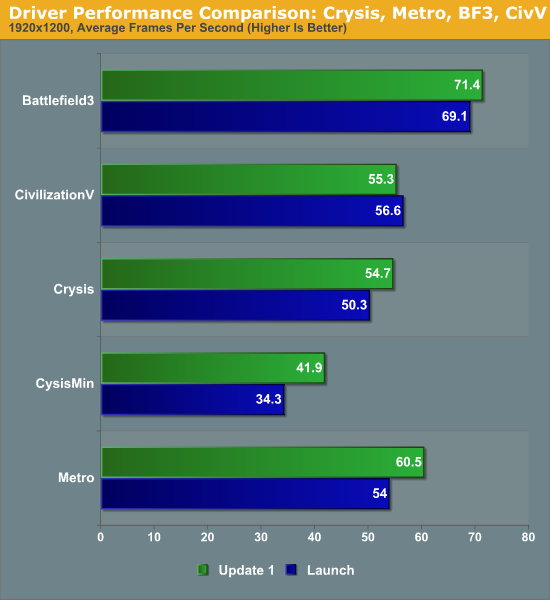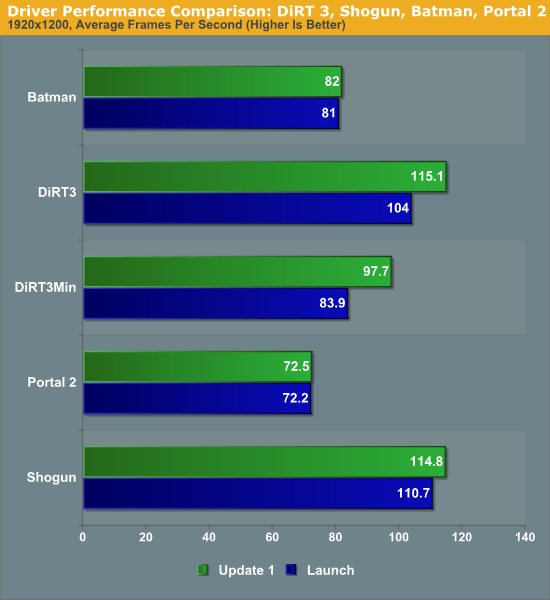AMD Radeon HD 7950 Review Feat. Sapphire & XFX: Sewing Up The High-End Market
by Ryan Smith on January 31, 2012 9:02 AM ESTGetting the Most Out of GCN: Driver Improvements
With the launch of any new architecture there’s still a lot of room for improvement on the part of driver developers, and GCN is no exception. On January 20th AMD released the first driver update for the 7000 Series, which brought with it an interesting mix of bug fixes, new features, and performance improvements. On the feature side AMD enabled support for Analytical Anti-Aliasing and Super Sample Anti-Aliasing for DX10+ games, an overdue feature that we’re very happy to see finally make it to AMD cards. Meanwhile on the performance side the new drivers improved the performance of the 7000 series in several games. Game performance typically rises slowly over time, but as this is one of the first post-launch driver releases, the gains are larger than what we’re used to seeing farther down the line.
To get an idea of where performance has improved and by how much, we reran our entire benchmark suite on the 7970.


As to be expected, at this point in time AMD is mostly focusing on improving performance on a game-by-game basis to deal with games that didn’t immediately adapt to the GCN architecture well, while the fact that they seem to be targeting common benchmarks first is likely intentional. Crysis: Warhead is the biggest winner here as minimum framerates in particular are greatly improved; we’re seeing a 22% improvement at 1920, while at 2560 there’s still an 11% improvement. Metro:2033 and DiRT 3 also picked up 10% or more in performance versus the release drivers, while Battlefield 3 has seen a much smaller 2%-3% improvement. Everything else in our suite is virtually unchanged, as it looks like AMD has not targeted any of those games at this time.
As one would expect, a result of these improvements the performance lead of the 7970 versus the GTX 580 has widened. The average lead for the 7970 is now 19% at 1920 and 26% at 2560, with the lead approaching 40% in games like Metro that specifically benefited from this update. At this point the only game the 7970 still seems to have trouble pulling well ahead of the GTX 580 is Battlefield 3, where the lead is only 8%.










259 Comments
View All Comments
chizow - Wednesday, February 1, 2012 - link
Perhaps, but judging by Newegg's current stock of 7950, supply is exceptionally good or demand is exceptionally soft for this product at its current price. Maybe somewhere in the middle?But as you said, if you don't like it, don't buy it and it seems in this case, capitalism works just fine. ;)
Gamer23 - Wednesday, May 2, 2012 - link
I was drooling when I first read about the Sapphire 7950 and the XFX 7950 DD, but now until AMD developes better drivers, I am still on the fence, and holding on to my 5850 Toxic. I believe most people are like me, $500? I'll sit back and wait, till I see better driver support, and a $300 dollar price tag! I believe you are right also about demand being soft, as I believe most purchases are fresh builds not upgrades.Gamer23 - Wednesday, May 2, 2012 - link
I totally agree with you, I am running a i7 940 with a 5850 Toxic, and even with all of the latest games that have recently come out, I am not even pushing this rig yet. Since games are now being locked at 60 fps, what's the sense of spending $500 for the latest and greatest and only getting 60 fps? Until game developers pull off the 60 fps govenor, (catering to console ported games) it will be a while yet before I am ready to let go of this Video card.xeridea - Tuesday, January 31, 2012 - link
I totally agree. I have a 6850 I got at a very good price. It runs any game on the market reasonably well. I run Crysis 2 with DX11 patch and texture patch @ 2048x1152 with reasonable framerates (I think my dual core is my bottleneck, usually I only get ~70% GPU utilization). I used to get cards slightly higher in generation performance, but these days it doesn't really matter with mostly crappy console ports.chizow - Tuesday, January 31, 2012 - link
I agree for the most part, but there are at least 3 major influences pushing game technology:1) Increases in VRAM usage in current games. Whether its due to MSAA, higher-res textures and texture mods, games like Skyrim, BF3, Metro 2033, Crysis 2 are really chewing up VRAM budgets on cards. These games will use 1.5GB no problem at 1080p, so just imagine higher resolutions or muti-display set-ups.
2) As mentioned, multi-display set-ups like EyeFinity or Nvidia Surround. They'll use up ~3x the VRAM as a single monitor and with increased AA requirements, that quickly adds up. In these instances, a 7950/7970 would shine over last-gen parts with less VRAM and bandwidth.
3) 3D. 1080p isn't that demanding anymore, but 1080p in 3D is roughly double the rendering requirements but puts an even greater emphasis on maintaining 60FPS minimums. Its really quite demanding and an area more GPU horsepower is always welcome, even with SLI/CF configs.
But yes, other than these niche areas there's probably not too much reason to upgrade at this point, especially when these offerings don't really shift the price/performance/value bar at all.
kashifme21 - Tuesday, January 31, 2012 - link
Well from personal experience i have GTX 580 in SLI. Both the cards have 1.5gb memory.I game at a resolution of 5760*1080. Unless i shift the AA to some crazy setting like 8x AA, my VRAM generally isnt a bottleneck.
I am currently playing a game like Skyrim at 5760*1080. Maxed out settings with 4X AA, FXAA & 4xTRAA
My game is mostly running locked at 60fps, sometimes in towns it does drop down to 45fps, however otherwise the experience is quite smooth.
Hence i would disagree that VRAM really is a limitation even at insanely high resolutions, 1.5GB Vram is pretty dam good.
Now with the next consoles only expected to be sporting GPUS like 6670, i wonder how Nvidia and AMD intend to keep both markets alive.
At one hand they support console gaming which doesnt really bring them too many chips a year and it will eventually cause PC gamers to stop upgrading. The business model looks like its going to axe their own feet.
chizow - Tuesday, January 31, 2012 - link
You must not run any texture mods at all, because Skyrim will use 1.5GB at only 1080p with only 2xMSAA+2xTSAA.Same for BF3, Crysis 2, Metro 2033 and quite a few other games with just highest-res official textures and 4xMSAA+2-4xTSAA.
JarredWalton - Tuesday, January 31, 2012 - link
I have a single 1.5GB GTX 580, and at 2560x1600 I definitely feel the lack of VRAM. If he doesn't notice lack of RAM at 5760x1080, I don't trust his judgement. (Hint: it's the minimum frame rates and stutters that come from the lack of memory; averages can be fine, but minimums often tank.)Sabresiberian - Tuesday, January 31, 2012 - link
Thanks Jarred for talking about performance where it counts, minimum frame rates and stutters.;)
chizow - Wednesday, February 1, 2012 - link
Yeah I completely agree about "feeling" the lack of VRAM, because it literally feels like I've submerged my mouse/monitor in oil or molasses. Idk the input lag and stutters from deferred AA just gets really unbearable once you start exceeding VRAM.But yeah I dropped a note in Ryan's 7970 closer look about PCIe bandwidth, VRAM and memory bandwidth. It'd be interesting to see how much of an impact PCIe bandwidth plays a role on cards with less VRAM, since that's when you'd expect more paging to system RAM over the PCIe bus. Also for memory bandwidth, although that's more between the GPU and RAM modules.
Anyways would be interesting to see something like that done using 1.5/3GB variants maybe a 580 and the 7950 when the 1.5GB arrives?